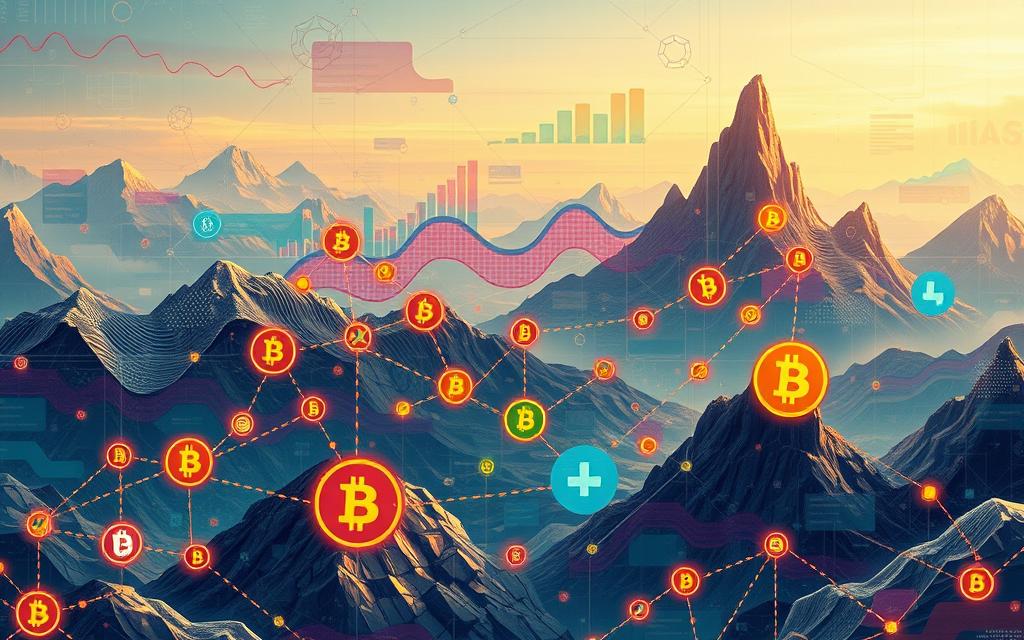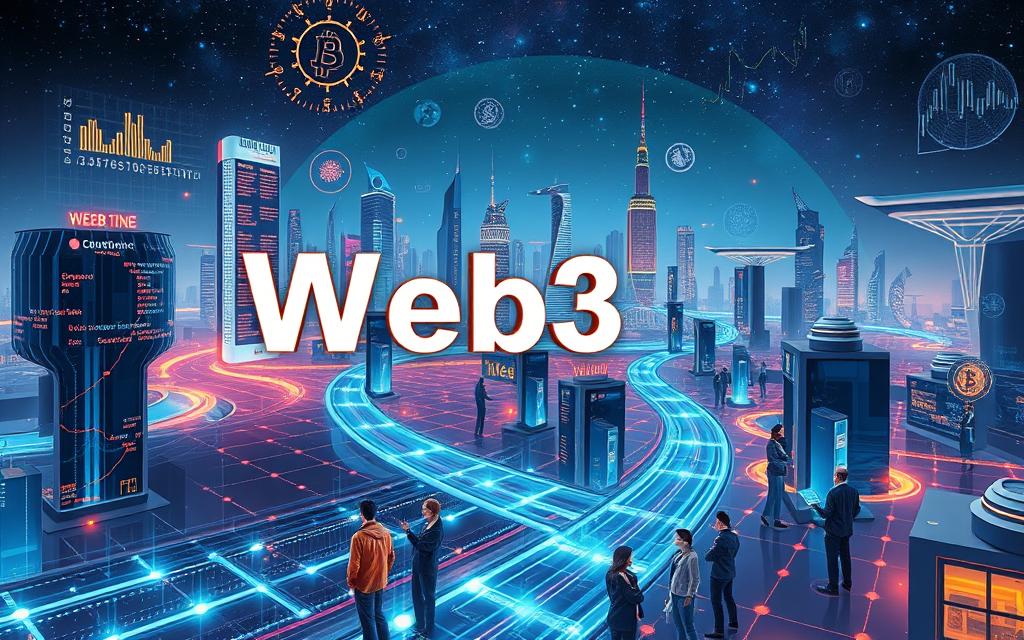Imagine a world where every action in a game can change the value of your assets. Welcome to the world of tokenomics in Web3 gaming. Here, the value of tokens shapes virtual economies and gives players real ownership. Your actions in the game could be a smart investment.
Web3 project funding is more than just getting money. It’s a shift in how we see and use digital value. It combines gaming, finance, and community management. Two key tokens are used: utility tokens for gameplay and governance tokens for decision-making.
In Web3 gaming, every detail is thought out. Players trade assets freely in Web3 marketplaces. Token burns and staking ensure the economy stays stable. The future of gaming is here, with tokenomics at its core.
Key Takeaways:
- Tokenomics is key to game economy design, using staking and play-to-earn.
- Utility and governance tokens have different roles, boosting gameplay and decision-making.
- ICOs help distribute tokens fairly, supporting startups.
- NFTs add scarcity and exclusivity to Web3 games’ economies.
- Dynamic pricing and decentralized governance create a player-driven economy.
- Supply and demand balance, along with treasury management, is vital for stable prices and value.
Introduction to Tokenomics in Web3 Ecosystems
Web3 gaming combines blockchain tech with gaming, bringing new ideas. It focuses on player control and economic involvement through owning in-game assets. Tokenomics, a key part, guides digital currencies in these digital worlds.
Tokenomics answers big questions about token demand and value distribution. It makes sure Web3 gaming is strong. It uses token utility and user incentives to encourage and sustain participation in Web3.
The Foundation of Web3 Gaming and Asset Ownership
Web3 gaming lets players own their in-game assets forever. This is thanks to NFTs, which prove ownership. It boosts engagement and opens up economic chances for players.
Decentralization and Transparency as Core Principles
Web3 games live by decentralization and transparency. They run on blockchain networks with DAOs, leading to community-driven decisions. This keeps transactions safe and builds trust among players.
Aligning Player Incentives with Token Utility and Governance
Token economies in Web3 projects motivate players. Token utility rewards players for their actions and contributions. Governance tokens let players vote on game updates and economics, making them feel responsible.
Good tokenomics combines scarcity, utility, and incentives in game design. It connects player interests with the game’s success. Web3 gaming changes how we play, own, and grow games.
Tokenomics, Cryptocurrency Economics, Token Value, Web3 Project Funding
Understanding tokenomics and cryptocurrency economics is key for Web3 project success. It’s not just about making tokens. It’s about managing their life cycle from token distribution to token staking. It also includes token burning to keep value and reward stakeholders.
Liquidity mining and token staking are vital. They keep the token’s economy stable and encourage community involvement. For example, staking platforms reward users with interest, securing the network and keeping tokens liquid.
Here’s a look at tokenomics:
| Key Aspect | Details |
|---|---|
| Token Distribution | Determines how tokens are given out among founders, investors, and users. It affects fairness and decentralization. |
| Token Minting and Burning | These control mechanisms manage token supply. They impact inflation and token scarcity. Examples include Ethereum’s minting and Binance Coin’s burning. |
| Utility vs. Governance | Utility tokens give access to services. Governance tokens let users vote on platform decisions. |
Minting new tokens can reward users, like Ethereum does for miners. On the other hand, token burning, as seen with Binance, reduces supply. This might increase token value.
Supply limits also play a role in market perception. For example, Bitcoin’s limited supply is designed to increase its value as demand grows.
In summary, the balance of token distribution, token burning, and token staking defines a project’s cryptocurrency economics. These practices secure the network and boost user engagement. They are the basis for strong economic policies in Web3.
Designing Sustainable Token Distribution Models
The need for strong Initial Coin Offerings (ICOs) is growing. Sustainable token distribution models are key for Web3 projects’ long-term success. It’s important to manage token supply and control inflation to create a balanced ecosystem.
Initial Coin Offerings and Token Allocation Strategies
In ICOs, token allocation is vital for fair distribution and growth. Good token allocation strategies reward investors and developers fairly. This aligns with their contributions and the project’s goals.
Working with blockchain development companies like Rock’n’Block can improve token distribution. They offer detailed solutions tailored to the project’s needs.
Controlling Token Supply and Inflation
Managing token supply and controlling inflation are key for a project’s economic health. ICOs can use token burns or staking to fight inflation. These methods reduce the supply, potentially increasing token value.
Changing token supply can affect its value. Too much supply can lead to inflation, while scarcity can boost demand. Bitcoin’s fixed supply is a model for maintaining value.

Using flexible issuance rates, like Ethereum’s Ether, helps token economics adapt. This supports a resilient ecosystem. It’s important for dealing with changes in user behavior and economic conditions.
Psychological factors, like loss aversion and the endowment effect, also matter in tokenomics. Tokens that tap into these can improve user acquisition and retention. This is vital for an ICO’s long-term success.
The Role of Token Utility and Player Behavior in Web3 Games
In the world of Web3 gaming, how tokens work and how players act are key. Knowing this helps make games fun and keeps gaming worlds alive.
Utility Tokens versus Governance Tokens
Web3 games use different tokens for different things. Utility tokens let players buy in-game items and unlock special levels. Governance tokens let players vote on game changes. This makes games more dynamic and fair, keeping players interested.
Reward Mechanisms and Player Engagement
Rewards are key to keeping players engaged in Web3 games. Good rewards celebrate player wins and help the game grow. By linking rewards to game goals, developers build a loyal community.
Token value is critical for success. Bad token design can lead to game crashes, like what happened with Axie Infinity. But, good tokens, like ETH and BNB, keep platforms strong and users happy.
In short, the success of Web3 games depends on balancing player rewards and influence. As we explore tokenomics, it’s clear that tokens are essential for the future of Web3 gaming.
Building and Managing Web3 Game Economies with Tokenomics
Web3 gaming has changed how we manage in-game economies. Tokenomics is key to creating markets that work well for both developers and players. It includes managing liquidity and using Non-Fungible Tokens (NFTs) to build strong economic models in digital worlds.
NFTs and their Impact on the In-Game Economy
NFTs have changed digital ownership and the in-game economy. They let players own unique items and hold real-world value. This makes games more engaging and financially rewarding.
By linking NFT value to rarity, utility, and demand, they raise the stakes in gaming. This is detailed in tokenomics insights. It shows how NFTs act as assets and currency in Web3 games.
Dynamic Pricing and Liquidity Management Strategies
Web3 game economies rely on dynamic pricing and liquidity management in tokenomics. Adjusting prices in real-time keeps the economy healthy. It stops inflation and keeps players interested.
Liquidity is also key for smooth trading. It lets players buy and sell without price swings or delays.
| Aspect | Implementation in GameFi | Impact on Economy |
|---|---|---|
| Dynamic Pricing | Real-time asset valuation based on market dynamics | Prevents stagnation and encourages active trading |
| Liquidity Management | Ensures availability of assets for trade | Reduces volatility, enhances stability |
| NFT Utilization | Unique, tradable in-game assets | Increases player investment and loyalty |
| Token Distribution | Balanced through ICOs, staking, and gameplay rewards | Ensures equitable access and mitigates inflation |
As Web3 gaming grows, managing liquidity and using dynamic pricing are more important. They help create game worlds that draw and keep players worldwide.
Conclusion
In the world of Web3, tokenomics is key to a project’s long-term success. It combines economics and blockchain technology in a special way. This ensures tokens have value and are part of a healthy ecosystem.
Tokenomics is about making sure tokens are useful and well-managed. This is essential for Web3 projects to do well. It’s not just good, it’s necessary.
Data shows that how well a token does in the market matters a lot. It’s not just about what the token can do. Finding the right balance is important to avoid problems.
As blockchain grows, so does its market value. It’s expected to reach USD 825.93 billion by 2032. This makes it even more important to have good token models.
These models need to understand how people think and act. They should make users want to be part of the token’s world.
The future of cryptocurrency economics is all about creating a fair and engaging environment. It’s not just about making tokens. It’s about building a solid economic base for Web3 projects.
Whether it’s security, utility, or governance tokens, the focus is on fairness and sustainability. This is what will make Web3 projects successful and accepted.
